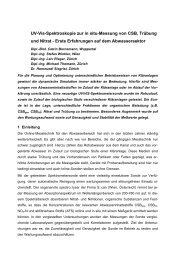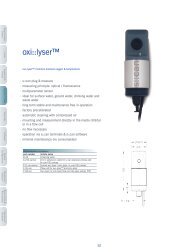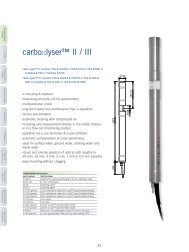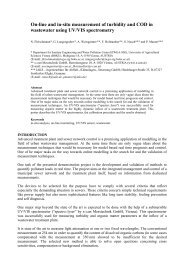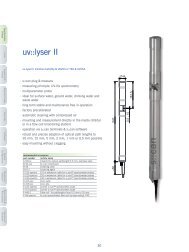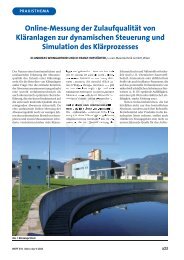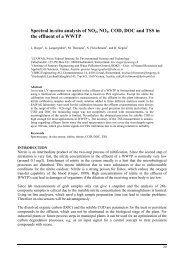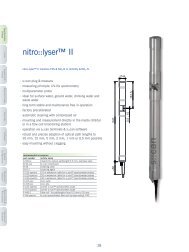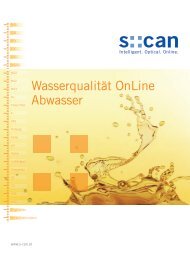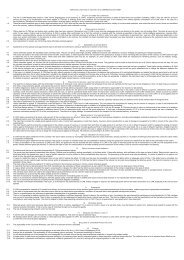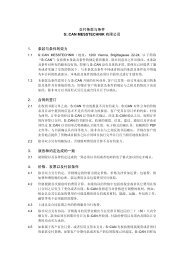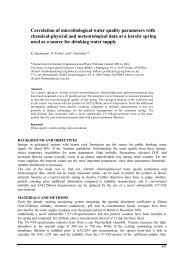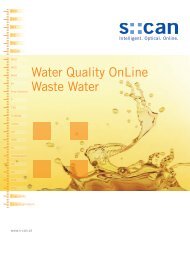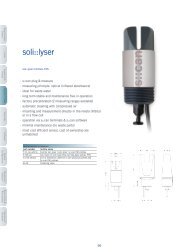Water Quality OnLine Drinking Water - S-can
Water Quality OnLine Drinking Water - S-can
Water Quality OnLine Drinking Water - S-can
Create successful ePaper yourself
Turn your PDF publications into a flip-book with our unique Google optimized e-Paper software.
Spectrometer<br />
Probes Probes<br />
i::s<strong>can</strong> Ionselective<br />
Probes<br />
Physical Probes<br />
Terminals Software System Confi guration<br />
Monitoring<br />
Stations<br />
Spare Parts &<br />
Accessories<br />
Services &<br />
Solutions<br />
Messgeräte Sonstige Daten<br />
Spectrometer probes<br />
“Why do we measure”<br />
To quantify the concentration of organic substances in drinking<br />
water and natural waters usually sum parameters such as TOC,<br />
DOC or SAC are used. These sum parameters <strong>can</strong> be used because<br />
the total organics is composed of a multitude of substances.<br />
As organic substances are on the one hand a source of food for<br />
micro-organisms and on the other hand they <strong>can</strong> be harmful<br />
themselves, their removal is an essential step in water treatment.<br />
The s::<strong>can</strong> carbo::lyser is used to continuously monitor the individual<br />
processes, such as adsorption and fl occulation, used for<br />
removal of natural organics. Furthermore, the instrument is used<br />
in online alarm systems to monitor the drinking water distribution<br />
network. Typically, in both applications the turbidity, also provided<br />
by the carbo::lyser, is used as an additional principal indicator<br />
for water quality.<br />
The spectro::lyser, which <strong>can</strong> measure the entire absorption<br />
spectrum, is used by many drinking water utilities worldwide<br />
as a pivotal component in their raw water monitoring. The<br />
spectro::lyser its capability to measure and analyse the absorption<br />
spectrum in its entirety allows the detection of a multitude of<br />
organic substances, and provide the best possible drinking water<br />
security when used to control ground, source and surface waters.<br />
The benefi ts of using a spectro::lyser or multi::lyser are even<br />
higher as the much greater information content of the data provided<br />
by these instruments: two different fractions of the organics<br />
<strong>can</strong> be distinguished (TOC, DOC) and simultaneously the levels of<br />
turbidity, nitrate and colour <strong>can</strong> be determined in a single measurement.<br />
In ground water high nitrate concentrations are the primary source<br />
of public health risks. When producing drinking water from such<br />
sources it is necessary to reduce the nitrate concentration in the<br />
water. Here the nitro::lyser is used both in the control of such<br />
processes (for example mixing of water from different sources or<br />
insitu nitrate removal) and in the monitoring of the raw water quality.<br />
The spectro::lyser <strong>can</strong> go one step further and resolve nitrate<br />
and nitrite concentrations separately. As nitrite is extremely toxic<br />
for most aquatic organisms, this feature of the spectro::lyser<br />
allows the real-time detection of conditions that endanger the ecosystems<br />
in surface waters.<br />
The spectrum of applications of the spectro::lyser in drinking<br />
water and natural waters is completed by online measurements of<br />
ozone (disinfection of drinking water), hydrogen sulphide (anoxic<br />
raw waters), disinfection by-product formation (drinking water)<br />
and single substances (for example benzene, toluene, xylene) in<br />
customer specifi c applications (e.g. contaminated ground water).<br />
The use of “delta spectroscopy”, the capability to determine many<br />
parameters simultaneously and the use of the spectral alarm software<br />
ana::larm makes the spectro::lyser an ideal tool for drinking<br />
water protection. As pivotal monitoring instrument in water<br />
quality stations the spectro::lyser detects potential threats to<br />
drinking water quality and security in real time.<br />
Absorbance [Abs/m]<br />
18<br />
500 120<br />
450<br />
UV radiation Visible radiation (Vis)<br />
400<br />
350<br />
300<br />
250<br />
NO2<br />
200 NO3<br />
150<br />
100<br />
COD_total<br />
BOD<br />
TOC<br />
Benzene<br />
Toluene<br />
Xylene<br />
Phenol<br />
50<br />
0<br />
DOC<br />
COD_dissolved<br />
200 250 300 350<br />
fi g. 1 : “fi ngerprint” absorption spectra<br />
Non-compensated spectrum; represents the<br />
dissolved and non-dissolved substances<br />
Turbidity, TSS (total dissolved solids), etc.<br />
20<br />
colour Turbidity-compensated spectrum;<br />
represents the dissolved components only<br />
0<br />
400 450 500 550 600 650 700 750<br />
Wavelength [nm]<br />
© s::<strong>can</strong> Messtechnik GmbH<br />
100<br />
80<br />
60<br />
40



